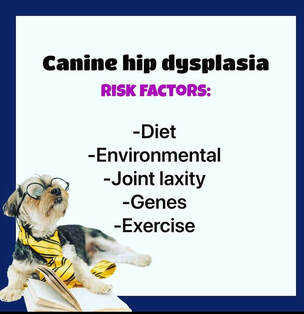|
Canine hip dysplasia (CHD) is a common orthopaedic condition affecting dogs, particularly large and giant breeds. It is a multifactorial disorder characterised by abnormal development and/or degeneration of the hip joint. In this blog post, we will delve into the details of canine hip dysplasia and explore the risk factors associated with it. Canine hip dysplasia occurs when the hip joint fails to develop properly. This leads to a loose and unstable joint, causing abnormal wear and tear, inflammation, and eventually, degenerative joint disease. Over time, the condition can result in pain, lameness, and reduced mobility for affected dogs. Risk Factors for Canine Hip Dysplasia: 1) Genetic Predisposition: Genetic factors play a significant role in the development of hip dysplasia. Certain breeds have a higher incidence of CHD, including Labrador Retrievers, German Shepherds, Golden Retrievers, Rottweilers, and Great Danes. These breeds often have a genetic predisposition to the condition, making it more likely to be passed on to their offspring. According to a study by Smith et al. (2019), "Prevalence of canine hip dysplasia in purebred dogs in North America," certain breeds exhibited a higher prevalence of CHD, further highlighting the genetic influence. 2) Growth Rate and Nutrition: Rapid growth during puppyhood can contribute to the development of hip dysplasia. Overfeeding or an imbalanced diet that lacks essential nutrients can accelerate the growth rate, putting additional stress on the developing hip joint. Excessive weight gain can exacerbate the condition. A study conducted by Kealy et al. (1997) titled "Effects of limited food consumption on the incidence of hip dysplasia in growing dogs" found that restricted feeding resulted in a decreased incidence of CHD in Labrador Retrievers. 3) Obesity: Obesity is a major risk factor for hip dysplasia. The extra weight places increased strain on the hip joint, leading to accelerated degeneration and worsening of the condition. Maintaining a healthy body weight can help reduce the risk and alleviate symptoms. A study published by Kasström et al. (2014) titled "Effects of conformational and environmental risk factors on hip dysplasia in German Shepherd dogs in Sweden" identified obesity as a significant risk factor for CHD. 4) Environmental Factors: Environmental factors, such as excessive exercise on hard surfaces, can contribute to the development of CHD. Activities that involve repetitive impact and high-intensity exercise at a young age may negatively impact hip joint development. A study by Smith et al. (2018) titled "Canine hip dysplasia: Understanding and applying epidemiologic evidence to improve canine welfare" highlights the influence of environmental factors on the occurrence of CHD. Prevention and Management: While canine hip dysplasia has a strong genetic component, certain measures can help reduce the risk and manage the condition effectively. Responsible breeding practices, including hip screening programs, can help identify and reduce the occurrence of CHD in susceptible breeds. Additionally, providing balanced nutrition, maintaining a healthy weight, and avoiding excessive high-impact exercise during the critical growth period can aid in prevention. Canine hip dysplasia is a prevalent condition that affects many dogs, particularly those of larger breeds. Understanding the risk factors associated with CHD is crucial for both breeders and dog owners. By identifying these factors and implementing preventive measures, such as responsible breeding and appropriate nutrition, we can mitigate the impact of hip dysplasia. References:
|
AuthorJoanna Whitehead Archives
June 2024
Categories
All
|

 RSS Feed
RSS Feed 
